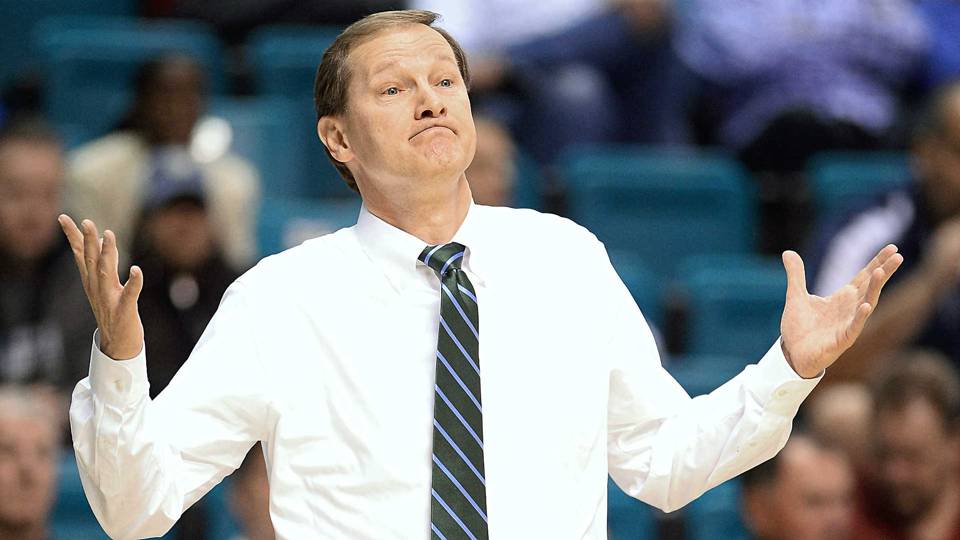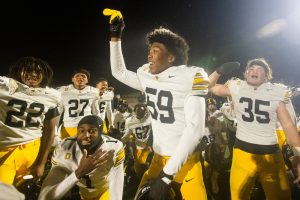Dana Altman’s breakthrough at Oregon began in obscurity. The Ducks were not ranked in the 2012-13 Associated Press preseason poll and, in fact, didn’t receive a single vote at the start of a journey that would culminate in the Sweet 16.
The same scenario unfolded two years later, when the Ducks went from nowhere to the Elite Eight.
Since the middle of the 2010s, Altman’s program has spent substantial time in the spotlight. The Ducks recruit at a high level, with five-star prospects and coveted transfers frequently relocating to Eugene.
Now closer to the end of his Oregon tenure than the beginning — he just turned 68 — Altman must navigate a new neighborhood in 2024-25, albeit from a familiar position.
The Ducks have been relegated to a secondary position in the Big Ten race, which includes preseason favorites Purdue, Indiana, UCLA and (dare we say it) Rutgers.
All of which prompts us to wonder: Does Altman have ’em right where he wants ’em?
Don’t sleep on the Ducks, folks.
Not with a sneaky-good rotation that features blue chip talents poised to flourish.
Not with a Hall of Fame-caliber coach who can match wits with anyone in the conference.
Not in an 18-team race that lacks a clear favorite and could prove hospitable for dark-horse teams.
The Big Ten preseason media poll is months from being released. When that day comes, likely in early October, the Ducks could find themselves on the second tier — perhaps in fifth place but more likely sixth or seventh.
Presumably, that would suit Altman just fine. After all, his best work often unfolds in the shadows.
Our projections for the Big Ten race …
1. Indiana. We aren’t convinced of Indiana’s status as a clear-and-obvious frontrunner, but the Hoosiers appear to have fewer flaws than other contenders thanks, in part, to three impact transfers from the Pac-12 in guard Myles Rice (Washington State), guard Kanaan Carlyle (Stanford) and center Oumar Ballo (Arizona). Add a solid returning core that includes forward Malik Reneau, and IU possesses the quality depth required to withstand the grind.
2. Oregon. Had the NCAA approved N’Faly Dante’s eligibility request, the Ducks would have been impossible to overlook. Without Dante, their focus will shift to a perimeter unit that includes gifted returnee Jackson Shelstad and Villanova transfer TJ Bamba, plus elite wing Kwame Evans Jr. The man in the middle, Nate Bittle, is a former five-star recruit who missed most of last season with an injury and illness. Oregon will have the flexibility to play big and small, fast and slow — and to win on the road.
3. Purdue. Veteran guards Fletcher Loyer and Braden Smith will form the pillars of a roster intent on proving it was more than Zach Edey. We don’t expect a steep regression in West Lafayette, but some backsliding is inevitable. The extent depends partly on Will Berg, a 7-foot-2 mini-Edey from Sweden who played sparingly last season.
4. UCLA. Renewed optimism in Westwood is rooted in the return of every top scorer except big man Adem Bona. But the core of coach Mick Cronin’s rotation was merely good enough to finish fifth in a mediocre conference last season. Granted, the experience gained by Dylan Andrews, Sebastian Mack and others should result in more consistency. But that improvement will be partly, if not fully offset by the elevated competition.
5. Rutgers. Amazingly, the Scarlet Knights signed the top recruits in the country at two positions: small forward Ace Bailey and wing guard Dylan Harper. Inconsistency from the freshmen is inevitable, which heaps pressure on returnee Jeremiah Williams and a handful of transfers. The season could veer in any direction, for Rutgers’ ceiling is as high as the floor is low.
6. Ohio State. The formula for success isn’t complicated: Take the momentum generated late in the season under coach Jake Diebler, add South Carolina transfer Meechie Johnson and Kentucky transfer Aaron Bradshaw, then account for the lack of a dominant team in the Big Ten. The result just might produce a contender in Columbus.
7. Michigan. The biggest name in Ann Arbor is Dusty May, who took Florida Atlantic to the Final Four two years ago and was one of the hottest coaches on the market this spring. He takes over a program that collapsed under Juwan Howard but should recover quickly given its tradition and recruiting prowess. May’s incoming class includes one of his former players, big man Vlad Goldin, who averaged 15.7 points and 6.9 rebounds for FAU.
8. Illinois: The 29 wins, top-10 ranking and Elite Eight appearance will mean zippo when the Illini take the floor in November. What will mean something: Terrance Shannon Jr. and most of the key rotation players have moved on, leaving coach Brad Underwood to revamp his roster. Granted, Underwood executes that task better than most, and the presence of former Arizona guard Kylan Boswell offers Illinois the chance to field a stellar backcourt.
9. Maryland. Much depends on the speed with which five-star freshman Derik Queen adjusts to the college game and coveted transfer Ja’Kobi Gillespie, who averaged 17 points for Belmont, adapts to the rigors of playing in a power conference. But make no mistake: The Terps possess significant upside and could make this projection look foolish by March.
10. USC. The Trojans are unrecognizable from last season’s edition, with an overhauled roster and new coaching staff. Eric Musselman was a tremendous hire and should make USC relevant in short order — perhaps even this season. Forward Terrance Williams knows the Big Ten well from his time with Michigan, while Xavier transfer Desmond Claude averaged 16.6 points in the Big East.
11. Michigan State. Picking a Tom Izzo team to finish this low in the Big Ten standings feels wrong in more ways than we can count. But without star guard Tyson Walker, the Spartans simply lack the talent needed to finish in the top half of the conference. Unless someone emerges unexpectedly under Izzo’s tutelage and the Spartans somehow defy expectations. And what are the odds of that?
12. Nebraska. We have reached a point in the proceedings where stating the obvious is probably wise: In an 18-team league, ties in the standings are inevitable. Don’t be surprised to see four teams tied for eighth place, or five teams tied for ninth. And that would be fine with the Hotline, because ties help mask our erroneous projections.
Related Articles
Big 12 MBB picks for 2025: Huge challenge awaits Four Corners schools
Arizona athletics: Desiree Reed-Francois’ challenging first 100 days
Mailbag: Buying Utah, Oregon FB in the fall and selling UW, Arizona
CFB recruiting: Cause for concern at USC after losing two 5-star DL
Washington’s budget forecast provides clues to Big Ten revenue distributions as an 18-team conference
13. Iowa. We considered the Hawkeyes for a top-10 placement but eventually decided to punt. (Ba-da-BING!) Seriously, offense isn’t an issue on the hardwood in Iowa City. The Hawkeyes were No. 16 nationally in adjusted efficiency last season (per the Pomeroy ratings) and bring back top scorer Payton Sandfort. But until proven otherwise, the defense is a massive liability.
14. Wisconsin. The last thing the Badgers needed after a mediocre season was a skewering by the transfer portal. Losing guard AJ Storr (16.8 ppg) to Kansas qualifies as exactly that. (And Storr wasn’t the only departure of significance.) Count Wisconsin as one of many programs that will lose competitive position in the conference with the arrival of the West Coast quartet.
15. Washington. Meet the newcomer most likely to struggle with life in the Big Ten. First-year coach Danny Sprinkle did well to rapidly retool the roster around his former Utah State star, Great Osobor. Washington has the potential for an upside surprise, but there are a few too many unknowns, including Sprinkle — he has never coached at the Power Five level — for the Hotline to slot the Huskies any higher.
16. Minnesota. Year Four will be massive for coach Ben Johnson, whose program finally gained traction last season and cannot afford a regression. Dawson Garcia’s return offers reason for hope, but the 6-foot-11 senior will need help — and plenty of it.
17. Northwestern. The Wildcats could be headed to their worst finish of the 2020s. On the bright side, we hear the new football facility will be spectacular.
18. Penn State. To be clear, the Nittany Lions weren’t the obvious pick for the Big Ten cellar and could finish several spots higher. Also possible: ties. So many ties.
*** Send suggestions, comments and tips (confidentiality guaranteed) to pac12hotline@bayareanewsgroup.com or call 408-920-5716
*** Follow me on Twitter/X: @WilnerHotline
*** Pac-12 Hotline is not endorsed or sponsored by the Pac-12 Conference, and the views expressed herein do not necessarily reflect the views of the Conference.












